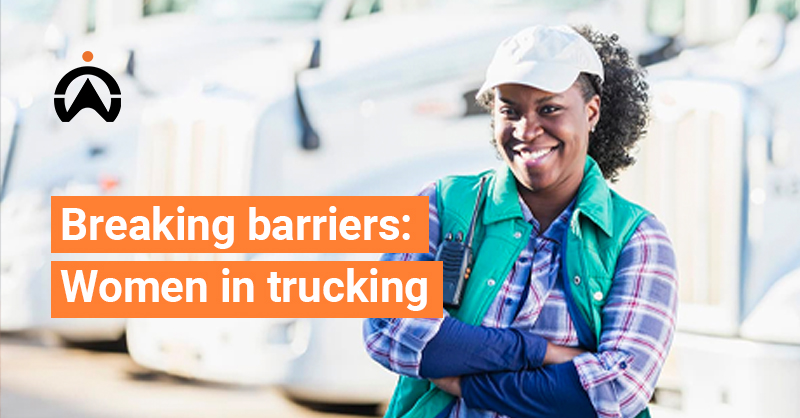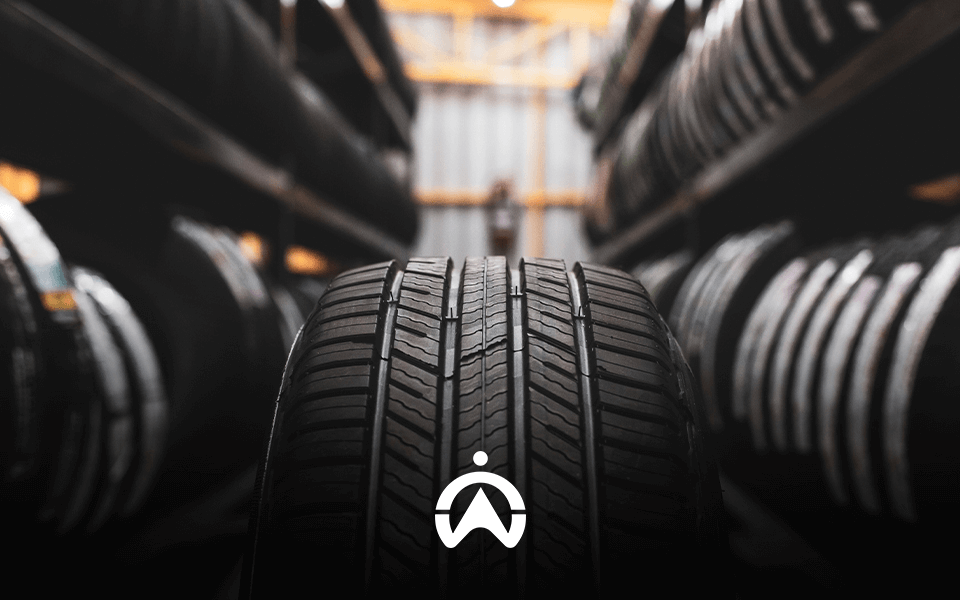Breaking barriers: women in trucking changing representations, evolving roles and rising their status
Truck driving has been perceived as a male-dominated industry, however, women have been breaking barriers and positively confronting stereotypes by stepping foot and increasing their representation in the trucking industry.
Over the years, women have been breaking industry barriers to entry by stepping foot into male-dominated blue-collar industries such as mechanics, engineering, construction work, and the focal point of this blog- truck driving. Despite the perceptions, backlash, and stereotypes women have come across over the years, women are increasing their representation in these male-saturated industries. In this blog, we explore the evolution, representation, as well as current and future possibilities of women in trucking.
Women and their representation in the fleet industry
Let’s face it, gender has contributed to how different industries are perceived and has influenced the career paths of both men and women. In the past, roles were largely based on gender types: domesticated and caring roles such as nursing and childcare were perceived as roles for females, upholding feminine and maternal stereotypes. While undomesticated roles were perceived as male roles, upholding masculine and paternal stereotypes. This has led to undeniably gender-segregated careers- mechanics, construction, engineering, and even the fleet industry.
Although the fleet industry is perceived as a male profession, this segregation has not stopped women from stepping into the industry. In return, companies are demonstrating an effort to close the gender gap in the fleet industry by increasing the representation of women in the industry:
The history and current state of women in trucking
Throughout history, trucking has been a predominantly male industry but women gained entry to the industry through a good cause. In the United States, the journey began with World War II when women stepped up to fill jobs of men who were at war, one of those jobs being trucking. While numerous women contributed to the early days of female trucking- in 1918 Luella Bates became the first woman truck driver and drove for Four Wheel Drive Auto Co while men were away at war; in 1929 Lillie Elizabeth Drennan was the first licensed truck driver and trucking-firm owner in the United States, and in 1944 Rusty Dow became the first to drive a 2 237km long fully loaded truck.
Since then, women have continued to step foot into the industry. In fact, according to a survey conducted by the National Transport Institute (NTI) the average percentage of female over-the-road (OTR) drivers increased from 7.13% in 2017 to 7.89% in 2018. The survey conducted by Frightwaves further shows that women now make up over 10% of OTR drivers, an increase from the 2018 survey. Recently, the percentage of female truck drivers has risen to almost 30% increase only in a period of a year (2018 to 2019). Currently, there are more than 300 000 in the United States alone. Canada has 97,000 women in the trucking and logistics industry of which 10% are truck drivers.
There is evident growth in the representation of women in trucking, still, there is a long way to go to curb the gender imbalance. Although women make up 47% of the labour force, the American Trucking Associations (ATA) reports show that only 6% of truck drivers are women. Additionally, there are countries where women are still combating discrimination of the division of labour being unequally distributed in patrilocal families- this is a heavier barrier to entry for women located in these countries.
- According to research conducted by Zippa,there are currently 4 682 fleet managers employed in the United States, of which 16.8% comprise women, increasing from 12.75% in 2011.
- The renowned fleet business- SMH Fleet Solutions, shows that the number of women in the fleet industry has risen in the year 2019, with the company having 33% of females in the workforce, and 35% first-line, middle and senior management.
- The US Bureau of Labor Statistics shows that the Trade, Transportation, and Utilities industry is the second largest employer of women in 2017, after manufacturing. Of the 7.7 million workers in the US Transportation and Utilities sector, women constituted 22.6%. There are 24.8% of women represented in the industry in 2021.
The above statistics verify that although women still represent the minority, the industry that was predominated by men is increasingly representing women and the number of women in the fleet industry is still on the rise. To better grasp the growth of women in trucking, let’s explore how women have evolved in the industry over time and how this has impacted the industry.
Female-owned trucking companies
Despite the aforementioned gradual growth and barriers to entry, women are working even harder, empowered more than ever before, have higher confidence and self-esteem, and are coming for the same recognition and equal representation in the trucking industry. As such, some women have moved from making their way into the industry to owning trucking companies. There are several female truck companies around the world, here are three success stories of female-owned trucking businesses:
- GoGirl Logistics:
Founded by Siphokazi Matsha in 2018, GoGirl logistics is a full-service logistics company that empowers other women in the industry through training and leadership programs and by hiring them.
- Veriha Trucking:
President and owner of Veriha Trucking- Karen Smerchek, runs over 250 drivers with the goal to attract more millennials, including women.
- Aria Logistics:
In 2013, Arelis Gutierrez founded Aria Logistics with the objective to simplify transportation management.
Why should women get into trucking?
If you are a woman reading this with a deep desire to ride in a heavy-duty powerhouse or own a fleet of them, there has never been a better time! The trucking industry is opening up for women. Although there is still work to be done in the representation, inclusion, and equality of women in the industry, women today are more empowered with resources and opportunities through social media spaces, organizations, and communities to share support, guidance, and information. There are also initiatives and programmes that strive to empower thousands of women in the fleet industry.
The trucking industry needs more women because it is becoming increasingly difficult for companies to find drivers. The estimated shortage of truck drivers in the United States is 120 000 in 2022. Although this impacts shippers and carriers across the country, it opens opportunities for more female drivers. Women could be the solution to the driver shortage in the trucking industry.
Additionally, trucking is a quick career to get into, provides freedom, and has job security. There is a shared preconception that to be in the fleet industry and have a successful career, you must have a keen interest in mechanics, or be a car enthusiast but that is not true. Those attracted to the fleet industry are drawn by the experience, tasks, adventure, and adrenaline of the daily challenges that are encountered.
Keeping in mind that each profession comes with its pros and cons, being a woman in trucking is not an easy job, but can be very rewarding. According to a study conducted by Deloitte in September 2016,lack of flexible schedule (33%), unattractive income (32%), unattractive work environment for women (31%), lack of opportunities for advancement (28%), and lack of work-life balance (27%) are some of the reasons European women stay away from the automotive industry. This is however changing, there has been a path paved by women throughout history, and the learning curve is less prevalent.
Women in trucking- confronting stereotypes and myths
The trucking industry is assumed a male profession, and with that comes the stereotypes and myths about the professional that could intimidate upcoming and existing women in trucking:
- Women are bad drivers
- Women do not have the physical strength and ability to be truck drivers
- Women cannot balance both life and work
- Female drivers are paid less than male drivers
- Female truck drivers are often in unsafe situations
The good news is that female truckers have proven to positively confront stereotypes:
- According to a survey conducted in 2020, men are 88% more likely to have a reckless or negligent driving conviction.
- Despite some myths, truck driving is a gender-neutral job as it does not require great physical strength to be a truck driver.
- Being a truck driver provides women with the flexibility and freedom that most jobs do not.
- Since professional truck drivers are paid based on the number of miles driven, there is no pay gap between men and women.
- As truck drivers, women do not have to face dangerous and unsafe situations that occur in public, as they ride solo with just their thoughts.
5 tips for aspiring female truckers
Being a minority group can be challenging. As a female truck driver, you need all the information, guidance, and support you can get. Here are 5 tips for aspiring female truckers:
- Finding a school or training program: To operate as a truck driver, you need a valid Commercial Driver’s License (CDL). There are various types of CDL Licenses, as well as various schools or training programs through which you can obtain your license. The trick is to find a school or training program that will go beyond merely teaching you to pass your driver’s test but also empower you with the education, driver development and soft skills needed to become attractive to the professional world.
- Get grants and scholarships to help you financially: You might not have the financial capacity to fund your own CDL- this should not stop you! There are grants and scholarships that you can find whether on your own, through female trucking organisations, or internal funding and grants within the school or program of your choice.
- Become part of a community: You do not have to do it all alone, join women trucking organizations for further support, guidance, and information. The trucking industry experience differs for men and women. Becoming a part of a community, allows you to connect with other women with shared experiences, and feel less lonely.
Choose a diverse and inclusive company: It is important to find a happy and healthy working environment that provides equal opportunity, support, respect, benefits, and pay for both male and female workers. Make sure you choose a company that desires to diversify its staff and aligns with your needs and values.
How you can diversify your fleet with Cartrack
Diversifying your fleet means having a range of age, ethnicity, gender, and more differences within your workforce. Trucking companies are shifting into diversification of the workforce. In the US 40.6% of all trucking jobs are held by minorities. Seeing the clear gender gap in the trucking industries, trucking companies should continue to strive for a healthy mixture in gender representation.
Adding a female touch to your fleet can bring a different perspective to how companies operate and engage with clients- this way, you can offer something for every taste and preference. Additionally, women can close the truck driver shortage and thus increase productivity.
To attract more women, companies need to offer a favorable working environment for them. Since truck driving is a male-dominated industry, some conditions may not be favorable for female workers.
Opportunely, technology can be used to fuel positive changes and progress in diversifying the trucking industry today by fostering better working conditions for women.
This is how Cartrack can help you attract female workers:
- Ensure your drivers are protected and safe: With the increase of violence against women globally, protecting female truck drivers should be a priority. According to the estimates by WHO 1 in 3 women have been subjected to either physical and/or sexual intimate partner violence or non-partner sexual violence in their lifetime.
Cartrack provides fleet management features that can ensure that female workers are always protected and feel safe:
- Routing: This software application will allow you to set and manage predefined routes for your fleet. This way, you can set the safest routes and receive real-time alerts in case of any route deviations.
- Replay route: This allows you to protect your drivers by always allowing access to footage to absolve drivers, reduce legal costs and smoothen insurance claims
- Panic Button: As an optional add-on to your fleet management package, a panic button can be used in case of an emergency. When the panic button is pressed, a silent alert will be sent to the Cartrack 24/7 control room where an operator will provide assistance.
- Protector: Give your female workers peace of mind with Protector. This is another optional add-on to your fleet management package, that provides a panic button for your drivers to access a range of services to make the work experience as worry-free as possible. With the push of the panic button, a call centre agent will contact the driver immediately to assist with any listed services.
- AI cameras and real-time location: Keep your drivers safe with AI-powered and live-streamed camera technology as well as with telematics and GPS tracking that lets you see exactly where drivers are, how they are driving, and if trips are on track.
- Empower your workers: Cartrack offers fleet management training which is intended to provide fleet managers, job dispatchers, and administrators with the skills and knowledge to get the most out of Cartrack fleet management solutions. By simply booking a session, managers receive training on all the latest software features and updates on the fleet management platform.
- Provide a work-life balance: Cartrack software solutions and easy-to-use mobile app help drivers complete jobs quicker, eliminate paperwork, and improve communication, making their lives easier.
Let Cartrack transform your fleet business for all types of drivers
The further increase of representation of women in the fleet industry is dependent on fleet companies to open up opportunities for women by hiring women, training women, and providing favourable working conditions for women.
Although diversifying your fleet can empower women, reduce driver shortage and increase productivity- it needs to be managed efficiently.
Contact Cartrack for a complete fleet management platform for your transportation and logistics business needs today.



